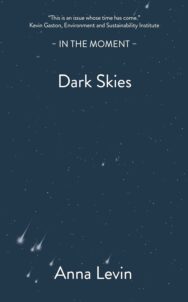‘Dark sky places are essentially reserves. Like anything endangered, darkness needs ring-fenced areas for its protection.’
With the clocks due to go back this weekend, we turned to Anna Levin to tell us all about why we should celebrate the dark skies. Her latest book is a celebration of the starry sky and the experience of darkness. In this extract, she recalls a visit to one of Scotland’s so-called Dark Sky Places.
Dark Skies
By Anna Levin
Published by Saraband
In a Dark Sky Place
“But why? I just don’t get it!” my friend grumbles. “There are dark skies throughout Scotland, so how can you say ‘this is a Dark Sky Place and not that, this island and not the next, this glen rather than that woodland’ – what’s it all about?”
I’d suggested a weekend at one of Scotland’s designated Dark Sky Places. We’ve got a fair few to choose from now. First there was Galloway Forest Park, then the Inner Hebridean island of Coll. The southern village of Moffat followed, then Tomintoul and Glenlivet Dark Sky Park in the heart of the Cairngorm Mountains. More recently, North Ronaldsay, the most north- ern island of the Orkney archipelago, became a designated dark sky community. And now the Isle of Rum is Scotland’s first International Dark Sky Sanctuary.
It’s true, I concede, that these are not necessarily the places with the darkest skies, and they may not be darker than neighbouring areas. And yes, we could drive north, south, east or west from here to a remote spot and be sure to find some glorious sky-gazing on a clear night. But the sky is only half the story. To become a designated dark sky area requires not ‘an exceptional or distinguished quality of starry nights’, but local people committed to keeping it that way. Where there is a dark sky designation, there’s also a shared human commitment to protecting and celebrating the darkness.
This was the additional lure for me. I wanted to meet the people who cared enough to set this process in motion and sustain it, measuring the sky quality, building a team, liaising with local businesses and explaining to other residents why it matters. In a dark sky place, there’s a heightened awareness and understanding of issues like the angles, intensity and brightness of outdoor lighting. Street lighting may be dimmed or directed to the ground instead of the sky and lights on public buildings will be softened. Above all, there’s a questioning: how much artificial light at night do we actually need?
Dark Sky status is awarded by the Arizona-based, globally active organisation Dark Sky International. Initiated by astronomers, it has now become a major global force with groups and chapters in many countries leading the counter-current against an over-lit world. Dark sky places are essentially reserves. Like anything endangered, darkness needs ring-fenced areas for its protection. There are now more than 200 certified places in more than twenty countries, including parks, sanctuaries, reserves, islands and communities, and a vibrant network of individuals working as dark sky defenders around the world. The Pacific Island of Niue became the first ever Dark Sky Nation in 2020, and New Zealand is on a mission to follow suit.
Like any reserve, the very concept has its limitations, as the natural world doesn’t observe our designated or legislated boundaries. Whales don’t stay within marine protected areas, nor birds within their sanctuaries. Pollution in the sea and sky can’t be kept out of these areas. The sky encompasses every- thing and has no boundaries. Skyglow smudges miles beyond its original source and the protected status of an area on Earth won’t alter the course of hundreds of thousands of low-orbit satellites. And yet, like any reserve, it’s a good starting place and a valuable intention. Crucially, it’s an acknowledgement of something of value, something that’s appreciated, noticed and worth concerted action to protect and preserve.
From this starting place there’s an upward spiral, a location now on the map as having something special in its sky. There’s also a connection to other dark sky places and people around the world. This stimulates interest among local residents and draws visitors in, boosting tourism and increasing the perceived value of darkness. ‘Astro-tourism’ has now become a ‘thing’ and interest is surging around the world. This is not just for spectacular and famous phenomenon like trips to Norway to see the northern lights, nor for the fanciest telescopes and astronomical facilities. There has also been a quiet resurgence – bolstered by dark sky places – of demand for a calm village with no streetlights; towns with soft lighting so you can visit the local pub and still stargaze on your way home; and local hotels with a star chart, a telescope, or a pair of binoculars on the windowsill. In our garish, glaring, too-bright society, darkness itself has a growing appeal and commercial value.
We decide on the Cairngorms. When we tell friends where we’re heading, they’re full of advice. It seems everyone has something to recommend, a favourite spot or cherished memory of the walk to Loch Mallachie, the ospreys at Loch Garten or the crested tits in the woodlands. No one mentions what for me is the main attraction: the darkness. I’m going to the Cairngorms to lie at night with the campervan window open and feast on the sky, to carry sleepy children out in their sleeping bags and show them a night full of stars and, when the night is cloudy, to relax at last into the balm of deep darkness. I can’t wait.
Extract taken from Dark Skies by Anna Levin. Published by Saraband on the 27th October, priced £8.99.














